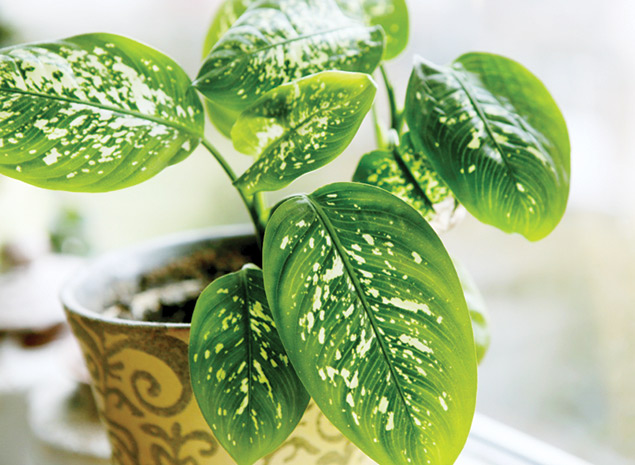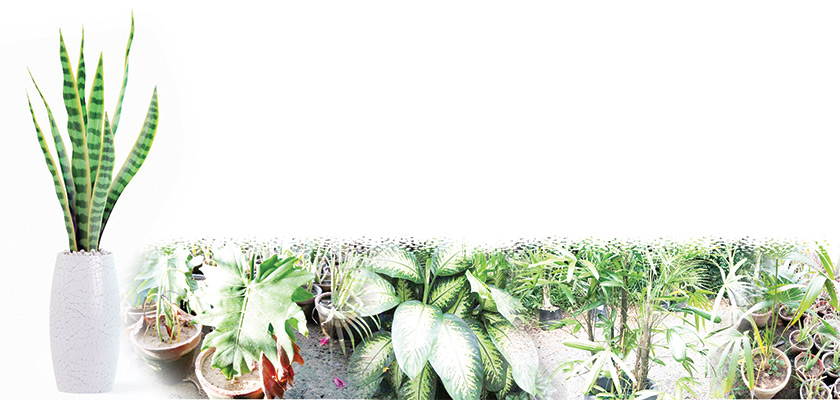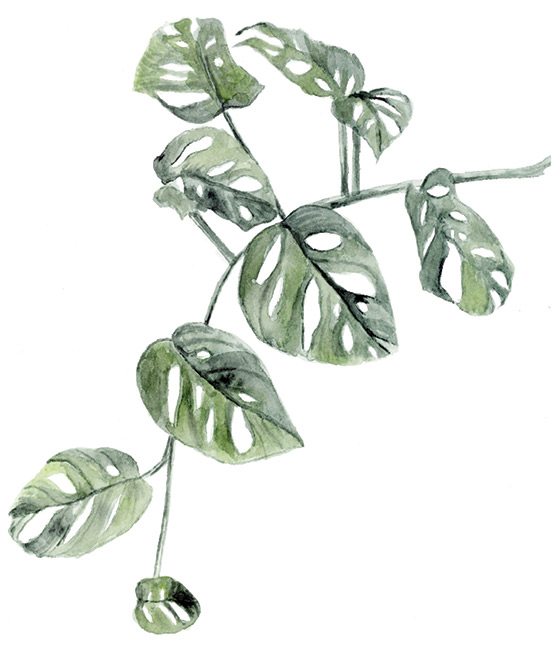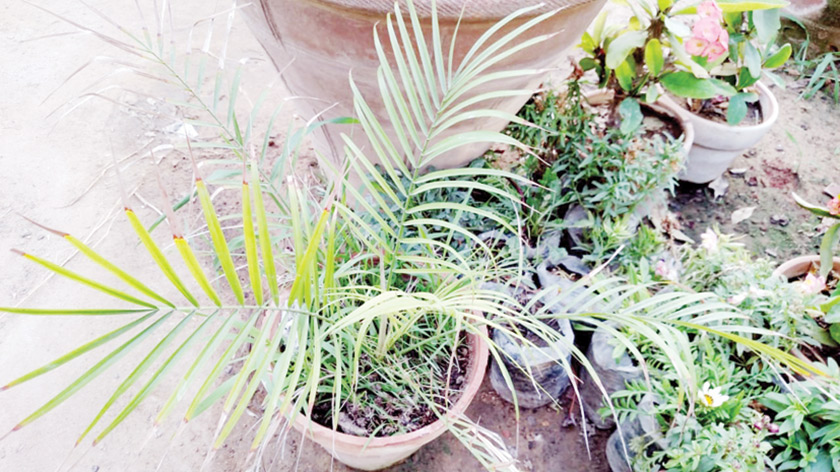Towards a greener living
COVER STORY
Ever wondered why offices are decorated with plants? Because they absorb the negativity spread by toxic people found at workspaces! In other ways, environmentalists say plants purify air; interior designers say they brighten up your space; psychologists say they lower stress levels in humans.
But does that mean you should blindly invest in pricy succulents and cactuses and bring them home to a quick death? Of course, not! Plants are one of the toughest creatures to deal with and are completely a no-go area if you are a lazy person.
So we decided to meet Ikram Khan, a professional gardener, at his spectacular nursery in Karachi, to find out what a successful indoor gardening experience looks like in our part of the world.
* Philodendron
They are loved for their unique shape and velvety texture; they come in several varieties and grow rapidly depending on how fertile the soil is. Solid green heart-shaped and split leaf (or monstera) philodendrons are commonly found in Pakistan. Some varieties also have white and red patches on their leaves.
Monstera is a special one because it has large, glossy green leaves with deep splits and holes. The great thing about them is they are highly adaptable to varied climatic and soil conditions. But philodendrons are highly sensitive to intense sunlight and that makes them the best indoor plants.
Other names: mexican breadfruit, hurricane pant
Price: Rs 150-200 (10-inch pot)
* Palm
Not all varieties of palm can be kept indoors. The palms with thin and delicate leaves (areca, windmill and bamboo palm) are the ones that thrive in low-light; while the palms with thick and spiky structure (fan and ponytail palm) need intense sunlight and wide space to grow. Indoor palms grow up really fast in summers and stand out in the space that’s why you usually find them in hotels and restaurants.
Other names: table palm, parlour palm
Price: Rs 50-70 (7-inch pot)
* Dieffenbachia
Leaves of dieffenbachia commonly found here are oval-shaped and robust; and the leaves could be of different colours. The one available here is green with patches of white; some have red streaks, too, but they are quite expensive.
Dieffenbachia is the strongest among indoor plants! Keep them in a pot for 10 years; don’t even change the soil, and maybe just water it twice or thrice a week and they will do great. But the problem is they are poisonous! If kiddos are around, don’t keep dieffenbachia inside.
Other names: dumb canes, leopard lily
Price: Rs 150-200 (10-inch pot)
* Boston ferns
This one is getting quite popular here but we see that it’s not preferred when decorating offices because it requires a lot of care. Instead, people get it for decorating their homes and lawns. Boston ferns can’t tolerate hot weather and need cool temperature, damp soil and a shady place to thrive.
Other names: sword ferns
Price: Rs 250-300 (7-inch pot)
* Snake plant
This low-maintenance plant is the easiest option for beginners. The towering structure of the pointy leaves adds to the life of the space and requires little to no care. Occasional fertilizing (once or twice a year) and watering (twice a week) will keep snake plant happy and healthy.
Other names: Elephant’s toothpick, mother-in-law’s tongue
Price: Rs 40-50 (5-inch pot)
Our hot climate doesn’t allow delicate varieties of indoor plants to grow well; usually you will find them in the cooler regions around the world. A lot of succulents and cactus are a part of it; maybe you can grow them in northern areas of Pakistan where temperature is usually 10 - 25 degree Celsius.
Now let’s see what areas to work on when you are taking care of houseplants.
Water
Overwatering is a common problem with many indoor plants. Remember sunlight helps remove all the extra moisture in the soil; but indoor plants don’t get direct sunlight which means soil is moist all the time and you don’t need to water everyday. Check the soil to make sure it is dry an inch down before watering lightly. Waiting three to four times a week is more than enough.
Especially plants like dieffenbachia and snake plant can die in no time if left for too long in soggy soil.
Soil
Indoor plants can survive in an infertile soil for a couple of months. If the soil gets infected by earthworms that usually creep in as soil ages and blackens, then you will have to immediately refresh the soil. Change soil twice or thrice a year or at least once! It is also important to make sure the soil is fine so that the excess water drains easily.
The fertilizer to sand ratio should be 1:1. It is not recommended to use urea for their indoor plants because it disrupts the balance of nutrients in the soil. Urea is used in commercial farming where soil is changed systematically with every new plantation. Or only professional gardeners can use it for growing seasonal flower beds or for speeding up the growth of plants in the gardens.
Controlling pests
The good news is houseplants usually don’t get infected by pests because they aren’t directly exposed to the wind. If something still shows up on the leaves or stems like white aphids that are very common here, go for natural solutions. I wouldn’t recommend spraying chemicals on houseplants. They are extremely hazardous and are only used by professionals in commercial settings. So I wound say boil neem leaves in water; let it cool down and spray the concentrated green water on every part of the plants. But before that, remove the pest with damp cotton.
And the bad news is insects like ants and earthworms commonly appear in the soil. To prevent that make sure your soil is never too soggy and you refresh it regularly. And changing place of your plants can also stop ants from following trail.
Temperature
The hot weather especially in Sindh and Punjab doesn’t support indoor plants. They will survive, but will not do well in terms of staying bright and sturdy. The ideal temperature is between 10 and 25 degree Celsius. Monstera and philodendron do quite well in banks and offices with air conditioning.
Pots
Plastic pots look adorable but they aren’t suitable for long-term gardening because the water doesn’t evaporate easily from that. I recommend clay pots only! Water dries out fast and the soil stays in a good shape.
I understand that people want their pots to look pretty, too, so I advise them to spray red oxide. Red oxide is just adds a finishing touch to the pots without clogging the pores of the clay pots.
Sunlight
Indoor plants can survive without direct sunlight but they need natural light and fresh air to survive. You can’t keep them inside a room that has no windows; even occasionally you will have to take them out in the sun and expose them to some fresh oxygen.
Towards a greener living
 Reviewed by Pak 24 News
on
April 12, 2019
Rating:
Reviewed by Pak 24 News
on
April 12, 2019
Rating:
 Reviewed by Pak 24 News
on
April 12, 2019
Rating:
Reviewed by Pak 24 News
on
April 12, 2019
Rating:













No comments: